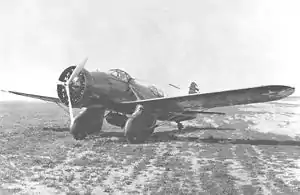Curtiss YA-10 Shrike
The Curtiss YA-10 Shrike (Model 59B) was a 1930s United States test and development version of the A-8 Shrike ground-attack aircraft using various radial engines in place of the inline Vee.
| YA-10 Shrike | |
|---|---|
 | |
| Role | Ground attack |
| Manufacturer | Curtiss/Curtiss-Wright |
| First flight | 1932 |
| Introduction | 1933 |
| Retired | 1939 |
| Primary users | United States Army Air Corps United States Navy |
| Number built | 2 |
| Developed from | A-8 Shrike |
| Developed into | A-12 Shrike |
Development
The Curtiss YA-10 Shrike was the first YA-8 fitted with a Pratt & Whitney R-1690-9 (R-1690D) Hornet radial engine. The conversion was carried out in September 1932, and it was found that the aircraft's performance was not degraded by the change of engine, and low-level maneuverability was improved due to the lower mass moment of inertia with the short radial engine. The USAAC preferred radials to inline engines for the ground attack role, due to the vulnerability of the latter's cooling system to anti-aircraft fire. The US Navy also preferred radials for carrier-borne operations.[1] Upon completion of testing the Army changed an order for 46 A-8B aircraft to the production version of the YA-10, the A-12 Shrike.
Operational history
Following completion of testing, the YA-10 was assigned to the 3rd Attack Group for operational service, then in 1934 it was assigned to the Command and General Staff School. The YA-10 was scrapped in early 1939.
The XS2C-1 was the Navy's first two-seat warplane. Since it was not equipped for carrier operations, it remained a prototype.[1]
Variants
- YA-10
- Model 59B, one U.S. Army Air Corps prototype
- XS2C-1
- Model 69, one U.S. Navy prototype with a 625 hp (466 kW) Wright R-1510-28 Whirlwind engine, delivered December 1932[2]
Specifications (YA-10)
Data from Aerofiles : Curtiss,[3] Curtiss Aircraft 1907–1947[4]
General characteristics
- Crew: 2
- Length: 32 ft 0 in (9.75 m)
- Gross weight: 6,135 lb (2,783 kg)
- Powerplant: 1 × Pratt & Whitney R-1690D Hornet 9-cylinder air-cooled radial piston engine, 625 hp (466 kW)
- Propellers: 3-bladed variable-pitch propeller
Performance
- Maximum speed: 175 mph (282 km/h, 152 kn)
- Cruise speed: 148 mph (238 km/h, 129 kn)
- Stall speed: 67 mph (108 km/h, 58 kn)
Armament
- Guns: 4x fixed forward-firing 0.30 in (7.62 mm) machine-gun, with another in the rear cockpit on a flexible mount
- Bombs: 10x 30 lb (14 kg) bombs or 4x 122 lb (55 kg) bombs
See also
Related development
Aircraft of comparable role, configuration, and era
Related lists
References
- "The Illustrated Encyclopedia of the 20th Century Weapons and Warfare" Editor: Bernard Fitzsimons (Purnell & Sons Ltd., ISBN 0-8393-6175-0) 1967/1969, Vol. 21
- "The Complete Encyclopedia of World Aircraft" cover Editors: Paul Eden & Soph Moeng, (Amber Books Ltd. Bradley's Close, 74-77 White Lion Street, London, NI 9PF, 2002, ISBN 0-7607-3432-1), 1152 pp.
- Eckland, K.O. "Curtiss # to J". aerofiles.com. Retrieved 14 April 2019.
- Bowers, Peter M. (1979). Curtiss aircraft, 1907-1947. London: Putnam. pp. 326–331. ISBN 0370100298.